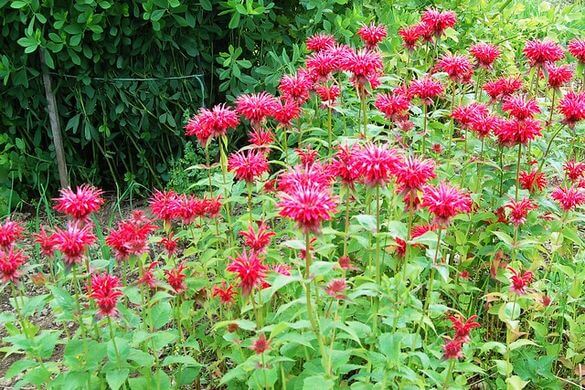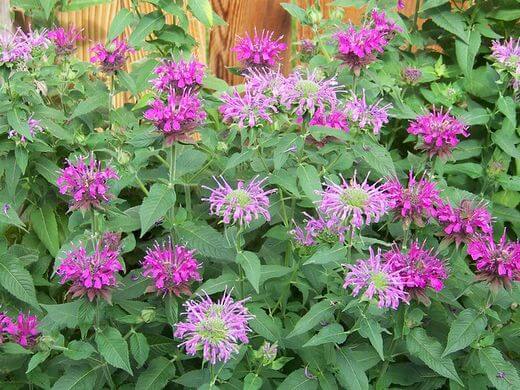The bee balm plant (Monarda didyma) is a perennial native to North America. This plant is especially common in the Eastern US and can be found growing in woodlands area and along stream banks. They typically grow up to around 2’ to 4’ tall and clump together in a cluster.

(Photo by: InAweofGod’sCreation/Flickr)
Most people recognize this plant from its unique flowers. The flowers have a cheerful shape that’s reminiscent of fireworks. The blooms come in gorgeous shades of white, red, pink, and purple. Not only beautiful, but bee balm flowers also attract pollinators, such as butterflies, bees, and hummingbirds. That’s why this plant is a great addition to any garden.
Edibility and culinary use
Aside from being beautiful, bee balm is also edible. As part of the mint family, the leaves and blooms have a minty taste and a pleasing citrusy aroma. Historical sources have noted that bee balm leaves and flowers are commonly brewed to make tea. This herbal tea is commonly known as Oswego tea in some parts of the US. this fragrant tea can help relieve sore throats and digestive issues.
These days, the colorful blooms are commonly used as an edible garnish in salads, desserts, and beverages. Fresh bee balm leaves are great for spicing up salads and adding flavor to beverages like lemonade and cocktails. Dried bee balm leaves also make a wonderful culinary spice. It can be used to substitute oregano and thyme is most dishes. The savory, mildly minty flavor pairs really well with egg, beef, lamb, and fish.
Health benefits

(Photo by: Mascdman/Wikimedia Commons)
Bee balm contains antiseptic, antibacterial, analgesic, antioxidant, and antifungal properties. That’s why this plant has long been used by Native Americans as a medicinal herb. As a natural antiseptic, the leaves can be applied topically or made into a salve to help heal minor wounds and infections. They’re also used to relieve inflammation from bee stings.
Meanwhile, the leaves and blooms are consumed mainly as herbal medicine. It’s especially effective for relieving headaches and digestive problems. Some people even swear by Oswego tea to treat common colds, sore throat, gingivitis, excessive gas, fever, and even PMS. Oswego tea is also soothing and relaxing. It works wonders for anxiety and also promotes better sleep.
Cultivation
Bee balm can serve as both an ornamental plant and as an edible herb. Its flowers will add a cheerful splash of color to your garden while attracting pollinators like hummingbirds to help other plants thrive. And it will serve as a great source of culinary herb and herbal medicine ingredient.
This plant is easy to grow. It loves moist soil that’s rich in organic matters and weed-free. It also requires a lot of sunshine to thrive but will tolerate partial shade, especially in hot areas. Bee balm is not fussy and requires little care. You only need to keep the soil moist. As a self-sowing perennial plant, the plant will reappear year after year without needing too much maintenance.

(Photo by: Patrick Standish/Flickr)
Start the seeds indoors around 8 to 10 weeks before the average last frost date. Harden of the seedlings and transfer them to your garden after the last frost. Don’t plant them too close together because they can spread quickly. Plant them 18” to 24” apart from each other.
Avoid harvesting the leaves during the first year to ensure optimum growth. The plant will start blooming in the second year and by this point, you can start harvesting the leaves and flowers. It’s recommended to harvest the flowers often to encourage quicker bloom production.
Cautions
While bee balm is generally safe to consume, it should not be consumed by pregnant women, especially in tea form. Oswego tea has been used as a natural remedy to induce menstruation and this might cause miscarriage in pregnant women.
Conclusion
It’s undeniable; bee balm is a wonderfully useful plant to have around. Bee balm can make your garden beautiful, help attract hummingbirds, and even become a great source of natural herbal remedy. As a hardy perennial plant, you can count on this lovely plant to come back year after year to cheer up your garden while also giving you great ingredients to spice up your dishes and make a soothing cup of tea.
---------------
Writen by Cornelia Tjandra
Cornelia is a freelance writer with a passion for bringing words to life and sharing useful information with the world. Her educational background in natural science and social issues has given her a broad base to approach various topics with ease. Learn more about her writing services on Upwork.com or contact her directly by email at cornelia.tjandra@gmail.com
Many of our readers find that subscribing to Eat The Planet is the best way to make sure they don't miss any of our valuable information about wild edibles.
See our privacy policy for more information about ads on this site







One Response
Do you have a go to list of edible raw flowers that are 100% non toxic to humans. Ie bee balm is edible but not for pregnant women. Thankyou